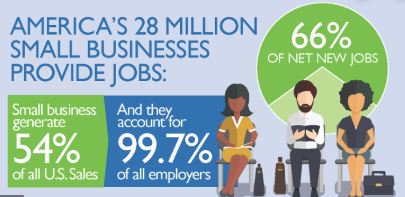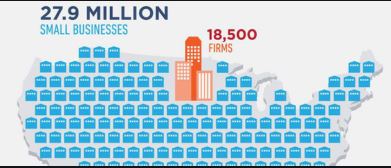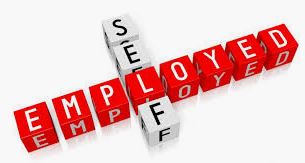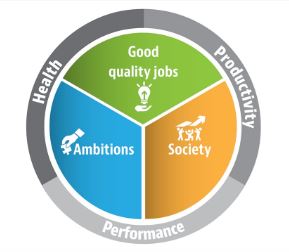Small Business and Economic Development: A Case Study

Business in general fuels an economy by producing jobs, creating merchandise that leads to spending, invigorating industries and strengthening gross domestic product. Small and large scale organizations contribute to gross domestic product and therefore influence the overall health of an economy. The new approach to economic growth has brought increased support to entrepreneurs and small business owners, simultaneously increasing focus on infrastructure and a well-trained, highly specialized, educated workforces. Why shift focus from large to small? Its been proven a sound model. When compared to a handful of massive operations, small businesses provide more jobs for a longer period of time. Additionally, large corporations often fail in cultivating emotional ties to the economies and communities in which they operate. Large business has an overwhelming objective to be as profitable and competitive as possible, outsourcing divisions, insourcing talents, exporting resources and importing cheaper supply chain options. Small businesses generally can't afford to recruit top engineering talent from India or move parts of their production process to China or Indonesia. Because of this, small business operations tend to be much more fruitful to the community than large business because small businesses must keep their operations local.
Consequently, large corporations are often relieved of tax obligations via tax breaks and incentives, regularly paying accountants to locate and exploit loopholes in tax law. Why would a community care about corporate tax breaks, you ask? The answer….standard of living. The standard of living within a community is hugely reliant on the collection and distribution of tax dollars. If you live in a poor neighborhood, devoid of mom and pops and replaced with Walmarts and Targets, your schools, parks, libraries, etc. will feel the loss in available tax funds. Poor neighborhoods specifically benefit more from small mom and pop establishments as dollars spent and income taxes accumulated remain local and are then made available to distribute for the benefit of the entire community. So, what measures where taken to draw these conclusions? The case study “The Role of Small and Large Businesses in Economic Development” by Kelly Edminston, outlines the benefits of supporting and elevating small businesses within an economy. Relevant markers in the study included net job creation, gross job flows, self-employment, job quality and innovation.

Net Job Creation
Net job creation identifies the difference between total jobs created versus total jobs dissolved. Edminston’s case study revealed the U.S. census attributed the majority of new jobs created in the United States to organizations with twenty employees or less. Net job creation considers the total amount of new jobs created by expansion and startups minus the amount of jobs that were destroyed by business closures and downsizing. In 2003, small businesses accounted for only 18.4% of total employment but were responsible for over 79% of net new jobs. Small businesses alone were accountable for 1.8 million jobs between 1990 and the year 2004. Last year alone (2018), small businesses added 1.9 million net new jobs and employed 47.5% of the private workforce.

Gross Job Flows
Gross job flow, or worker reallocation, is a measure of employment status changes. In terms of this case study, gross job flows were mostly captured by expanding on existing businesses rather than from complete startups. This is still an important feature of small business as successful ones eventually grow and transcend classifications from small businesses to mid-sized or even large organizations, all of which constitutes an employment status change. These transitions validate fluctuations in both net job creation and gross job flows, and is also an indicator of labor force volatility.

Self-employment
Self-employment is arguably the most important entity in the small business world because many small organizations began with a single individual and no employees. As a self-employed individual gains momentum, new employees are hired and the startup transforms into a small business. At the time of this case study, 75% of businesses were classified as self-employed in the United States and only accounted for 3% of total sales annually. These self-employed individuals may not be contributing greatly to gross domestic product but 75% is a large pool from which many small business, and consequently many jobs, could emerge.

Job Quality
So, small businesses provide significant contributions to job creation, got it. But how does small business employment compare to its big business counterparts? First off there is the money. Simply put, large organizations have the resources to offer higher wages. Small businesses, however, have the operational space to employ low wage, low skill workers. Low wage workers mustn’t be ignored as they are a part of our communities and economies. If the bar for employment entry is set to high, poverty rates increase and individuals with limited capacity and limited resources are not able to provide for themselves. Social services become taxed with the demands of the poor and the tax system and community foot the bill. Larger firms tend to have more stressful work environments, minimal flexibility and less autonomy. Small firms often offer a better work-life balance as they may offer more flexible schedules, lenient work environments, and more freedom and creativity. Freedom and creativity contribute greatly to the innovative nature of small businesses and entrepreneurs. Small businesses are better suited to respond and accept innovation than their larger counterparts due in part to a lack of bureaucracy, heavier competition, and stronger incentives (i.e. personal rewards). Small businesses are crucial to innovation in today’s marketplace and are often the technological leaders of many industries.

Big Businesses Have Big Perks
All credit, thus far, has been given to small businesses as the cornerstone of American economic health. Big businesses are not given a lot of credit for what they do for the individual, the community or the state. However, big businesses can be counted for several perks, contributing to standard of living by way of security and stability. In the area of fringe benefits and workplace diversity, big businesses consistently outpace their small business peers. Big businesses often offer higher job security and stability as they are often more solvent and less susceptible to the minor bumps and bruises of the economic business cycle. Health insurance, long-term care insurance, injury compensation and disability benefits are nearly non-existent amongst small businesses but are a standard in most large corporations. Statistically, large corporations are most likely to have more diverse representation throughout its ranks by way of employing more women, individuals with disabilities and members of minority communities. Large companies also tend to experience less worker turnover as they are able to offer higher wages, better benefits and more job stability/security.








